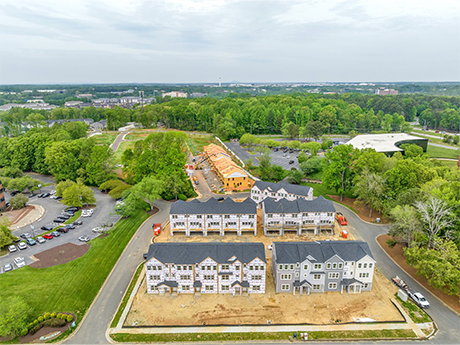The single-family rental (SFR) market, including purpose-built build-to-rent (BTR) communities, is the fastest-growing segment of the U.S. housing market, outpacing both single-family for-sale and multifamily growth in recent years.
Although the concept emerged from the Great Recession, when large investors began buying up vacant homes to rent, it has evolved significantly over the past five years, attracting more sophisticated investors and expanding into new markets.
Historically, Sun Belt markets, particularly Phoenix, were early adopters of BTR. Recently, however, areas like the Carolinas, Northern Virginia and even Boston have seen a surge in BTR development, driven by demographic shifts, renter preferences and the scarcity of affordable for-sale housing.
The growth of BTR in the Carolinas is especially notable. Fueled by in-migration since 2020, rising local payrolls, favorable development conditions and a strong base of reputable homebuilders, cities like Charlotte, Wilmington and Myrtle Beach have become prime targets for BTR developers and investors.
Both North and South Carolina have experienced robust population and job growth, along with strong rent increases. From 2020 through 2023, North Carolina added 381,679 residents and 425,300 jobs, for growth rates of 3.7 and 9.2 percent, respectively.
Projections show the state will add another 427,200 residents by 2029. South Carolina, too, experienced strong growth, adding 241,404 residents, a 4.7 percent growth rate, between 2020 and 2023. An estimated 193,276 more residents will move to South Carolina by 2029.
While multifamily fundamentals are strong across the region, Charlotte, known as the Queen City, stands out for its rapid adoption of the BTR model.
Supply Surge Coming to Charlotte
Charlotte’s BTR pipeline — approximately 4,156 units under construction and 3,000 in lease-up — is second only to Phoenix in size. This reflects strong demand for alternative rental options, as in-migration and job growth continue to outpace other regions.
Charlotte is projected to add more than 56,000 new residents by year-end 2025. Median household income, which is also on the upswing, is expected to grow by 3 percent to more than $80,000, a match to the national average, before 2026.
In 2024, the Charlotte metropolitan statistical area saw roughly 3,000 BTR units delivered across 29 communities, with the majority concentrated in Mecklenburg County. These units range from single-family detached homes to townhomes, offering features such as garages, private yards and high-end finishes.
One reason that Charlotte has become a Sun Belt leader in BTR is the city’s willingness to adapt its development ordinances. Through the Unified Development Ordinance, or UDO, for example, multifamily developers are now permitted to build higher-density housing in more locations with reduced parking requirements.
The city also has available land and lower all-in build costs compared with cities like
Raleigh or Asheville, making it more feasible for developers to bring these communities out of the ground.
It also helps that 10 of the largest homebuilders in the country have a footprint in Charlotte, giving them scalability, efficiency and lower costs.
While Charlotte’s multifamily rental market is projected to see 2 percent annual rent growth by the end of 2025, BTR rents are expected to be in the 4 percent range, nearly double the growth of traditional multifamily housing.
Coastal Markets’ Unique Challenges
Although they are smaller markets overall, Wilmington, North Carolina, as well as Charleston and Myrtle Beach, South Carolina, are also seeing strong BTR demand and development.
In Wilmington, in-migration from other states, a strong university and airport, good jobs and the availability of relatively affordable land compared with other major metros are compelling drivers. The metro currently has more than 2,500 units in the leasing stage — even more than Raleigh — and approximately 1,000 under construction.
In cities like Charleston and Myrtle Beach, where home buyers face a scarcity of supply, the single-family rental market is answering a need. Charleston has more than 1,100 BTR units in lease-up and about 200 under construction, while Myrtle Beach has over 840 units in lease-up and more than 400 units under construction.
Despite their strong in-migration and job markets, coastal cities present challenges for BTR development. Higher insurance costs, labor shortages and environmental constraints, such as wetlands and flood zone regulations, can drive up construction costs.
Why BTR Works in the Carolinas
Several factors make BTR a viable option in the Carolinas:
Favorable zoning and development policies. Pro-development policies and updated zoning ordinances streamline entitlement and building processes. For example, the UDO, which went into effect in 2023, permits construction of duplexes, triplexes and fourplexes in areas previously restricted to single-family homes. The UDO also introduced new zoning specifically for townhomes and small apartment buildings.
Charlotte also established the CLT Development Center in 2020, which offers developers direct access to city staff for permitting and development services, ideally leading to smoother project approvals.
Lower land and construction costs. Compared with more expensive markets like Raleigh or Asheville, cities like Charlotte and Wilmington offer affordable development opportunities.
Strong renter demand. High interest rates and a shortage of for-sale homes make renting a more attractive financial option for many. According to research firm John Burns, the cost of purchasing a home is now $1,091 more per month than renting a comparable property.
Institutional investment. Major institutional investors, including Blackstone-backed Invitation Homes, Ares, Greystar and AvalonBay, are acquiring BTR assets in the region.
Clear exit strategies. Institutional investors see BTR as a long-term, scalable asset class and are often willing to pay a premium for well-located, high-quality communities. Nationally, institutional investment is expected to represent the majority of BTR investment nationwide by 2030. With more than $70 billion in capital projected to flow into the sector over the coming years, developers throughout the Carolinas stand to benefit from strong demand from investors and renters alike.
— Caleb Troop is a senior managing director with Berkadia and is based in Charlotte. He can be reached at [email protected]. This article originally appeared in the January/February issue of Southeast Multifamily & Affordable Housing Business.


